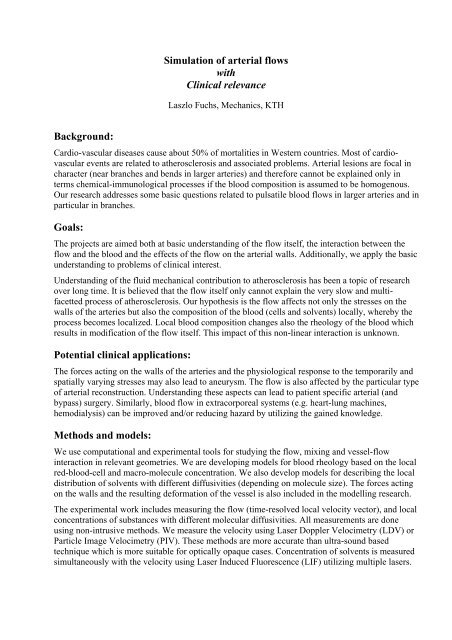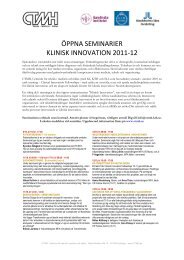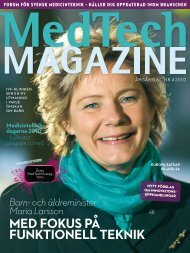Visualisering av funktionell och morfologisk hjärt-kärl-diagnostik
Visualisering av funktionell och morfologisk hjärt-kärl-diagnostik
Visualisering av funktionell och morfologisk hjärt-kärl-diagnostik
Create successful ePaper yourself
Turn your PDF publications into a flip-book with our unique Google optimized e-Paper software.
Simulation of arterial flows<br />
with<br />
Clinical relevance<br />
Laszlo Fuchs, Mechanics, KTH<br />
Background:<br />
Cardio-vascular diseases cause about 50% of mortalities in Western countries. Most of cardiovascular<br />
events are related to atherosclerosis and associated problems. Arterial lesions are focal in<br />
character (near branches and bends in larger arteries) and therefore cannot be explained only in<br />
terms chemical-immunological processes if the blood composition is assumed to be homogenous.<br />
Our research addresses some basic questions related to pulsatile blood flows in larger arteries and in<br />
particular in branches.<br />
Goals:<br />
The projects are aimed both at basic understanding of the flow itself, the interaction between the<br />
flow and the blood and the effects of the flow on the arterial walls. Additionally, we apply the basic<br />
understanding to problems of clinical interest.<br />
Understanding of the fluid mechanical contribution to atherosclerosis has been a topic of research<br />
over long time. It is believed that the flow itself only cannot explain the very slow and multifacetted<br />
process of atherosclerosis. Our hypothesis is the flow affects not only the stresses on the<br />
walls of the arteries but also the composition of the blood (cells and solvents) locally, whereby the<br />
process becomes localized. Local blood composition changes also the rheology of the blood which<br />
results in modification of the flow itself. This impact of this non-linear interaction is unknown.<br />
Potential clinical applications:<br />
The forces acting on the walls of the arteries and the physiological response to the temporarily and<br />
spatially varying stresses may also lead to aneurysm. The flow is also affected by the particular type<br />
of arterial reconstruction. Understanding these aspects can lead to patient specific arterial (and<br />
bypass) surgery. Similarly, blood flow in extracorporeal systems (e.g. heart-lung machines,<br />
hemodialysis) can be improved and/or reducing hazard by utilizing the gained knowledge.<br />
Methods and models:<br />
We use computational and experimental tools for studying the flow, mixing and vessel-flow<br />
interaction in relevant geometries. We are developing models for blood rheology based on the local<br />
red-blood-cell and macro-molecule concentration. We also develop models for describing the local<br />
distribution of solvents with different diffusivities (depending on molecule size). The forces acting<br />
on the walls and the resulting deformation of the vessel is also included in the modelling research.<br />
The experimental work includes measuring the flow (time-resolved local velocity vector), and local<br />
concentrations of substances with different molecular diffusivities. All measurements are done<br />
using non-intrusive methods. We measure the velocity using Laser Doppler Velocimetry (LDV) or<br />
Particle Image Velocimetry (PIV). These methods are more accurate than ultra-sound based<br />
technique which is more suitable for optically opaque cases. Concentration of solvents is measured<br />
simultaneously with the velocity using Laser Induced Fluorescence (LIF) utilizing multiple lasers.




